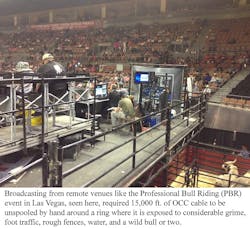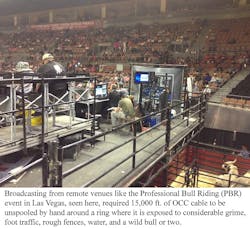Fiber-optic cables meet increasing demands for broadcast and AV installations
By Ed Sullivan, Optical Cable Corp. (OCC) -- The wide use of HD video, the emergence of 4K and 8K ultra-high broadcast standards, and increasing popularity in the audio-video (AV) sector is placing greater demands on data transmission systems. Fiber-optic technology, with its ability to deliver digital, high-bandwidth and low signal-loss streams, provides an ideal solution for coping with those demands.
However, when it comes to remote broadcasting from harsh conditions, the advanced needs of permanent broadcasting studio infrastructures, and the increasingly popular use of AV technology among businesses and government agencies, a new set of demands is being placed on the fiber-optic cable industry.
Field deployment applications
Sporting events are among broadcast's toughest venues, requiring the rapid pulling of miles of field-deployable fiber-optic cable across fences, through water, around rough-hewn rodeo arenas and along frozen ski slopes or blazing racetracks. Remote broadcasts demand the brisk deployment of dozens of strands of cable to cameras that fly over football fields, hang from cranes, and are then re-gathered and tossed into crates to be shipped to the next tough venue. Most important, in all of these harsh broadcasting environments, it must survive again and again.
Remote broadcasting specialists such as IMS Productions are involved with such rigorous field environments throughout the year. Headquartered across from the famed Indianapolis Motor Speedway, IMS Productions Mobile Unit Group travels the nation in heavy-duty trucks equipped with studios and satellite uplinks that provide live production services for national sports and entertainment broadcasts and events.
“Our fleet of mobile studios travels to hundreds of events across the country throughout the year, sometimes having to set up and tear down the same day before heading to the next venue,” says Paul Nijak, IMS Productions' director of engineering. “Even with all the rigors of meeting this schedule, remarkably little fiber cable gets broken – perhaps one or two pieces a year.”
One of IMS Productions' typical weeks includes providing broadcast production for the Verizon IndyCar Series, in locations such as St. Petersburg, where the 1.8-mile, 14-turn circuit incorporates city streets and a section of airport runway where 100,000 ft. of broadcast cable are laid behind temporary walls and fences, flown across sections of track and sometimes pulled through swamps and waterways.
Immediately following the race, IMS Productions crew will gather up the cable and head cross country to a PBR (Professional Bull Riders) Built Ford Tough Series event, where an average of 15,000 ft. of cable is unspooled by hand around a ring where it is exposed to considerable grime and foot traffic.
Additional savings on the plug and play cable can also be realized when it is pre-terminated at the factory, which means it has also been pre-tested by factory technicians. This also provides a greater degree of reliability and reduces the time to certify the installed system.
OCC’s comprehensive line of SMPTE 311-compliant cables rounds out the company’s cable offerings, providing a range of products for a variety of audio, video and broadcast applications.
Ed Sullivan is a Hermosa Beach, CA-based writer. He has researched and written about high technologies, healthcare, finance, and real estate for over 25 years. For more information contact: Optical Cable Corporation, 5290 Concourse Drive, Roanoke, Virginia, 24019; Phone: (800) 622-7711, Canada (800) 443-5262; FAX: 540-265-0724; Email: [email protected]; Visit the web site www.occfiber.com.

